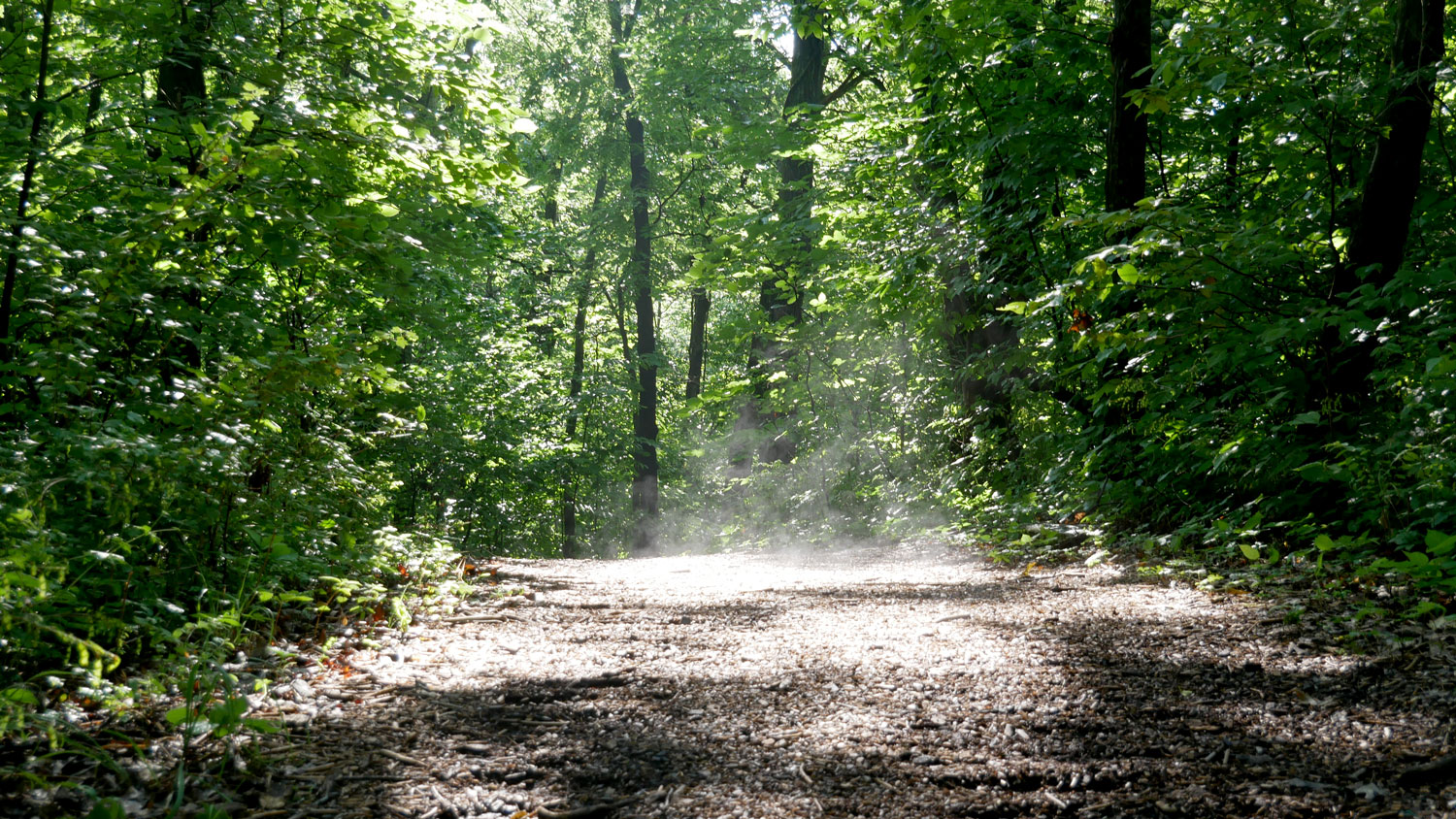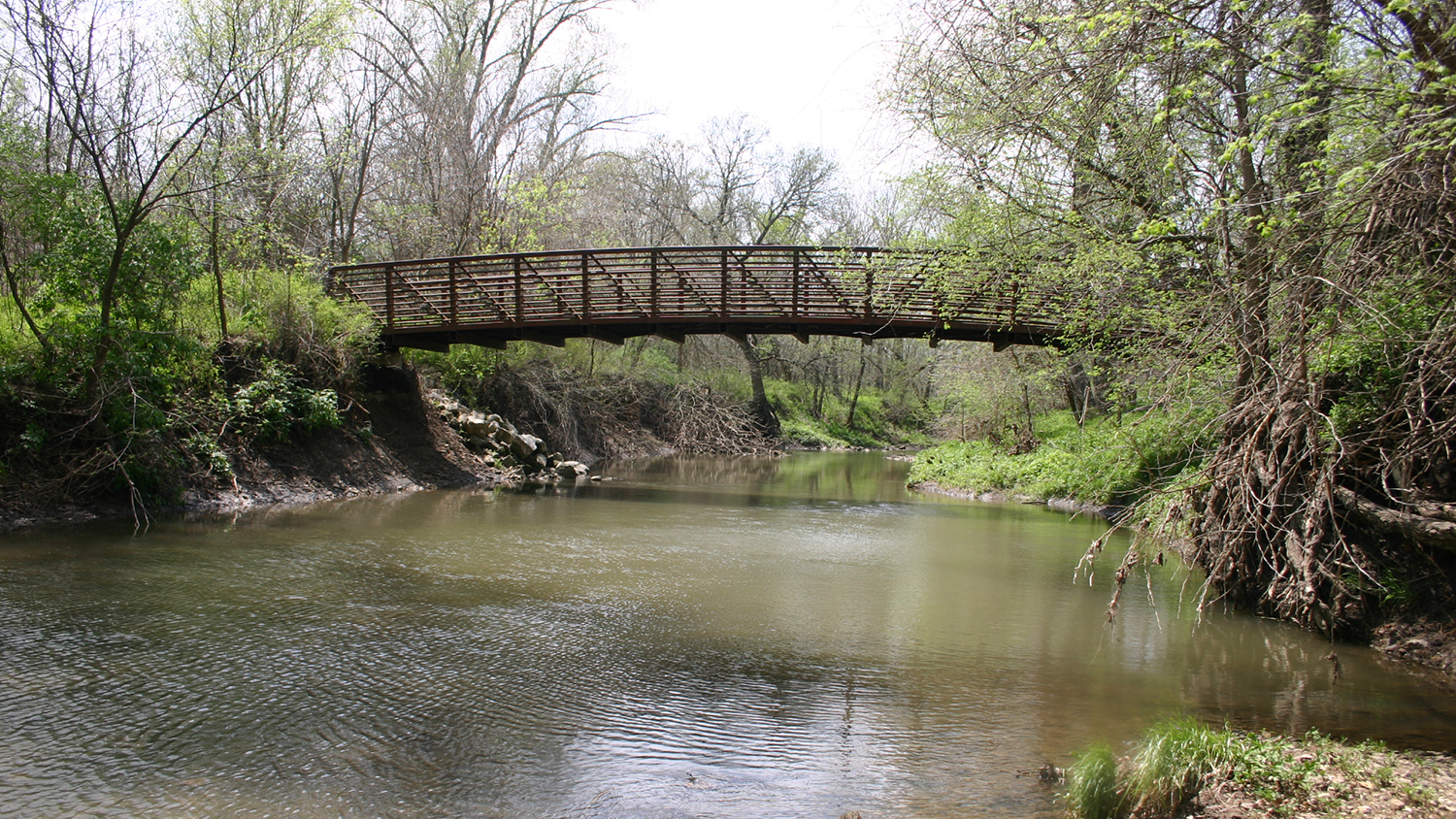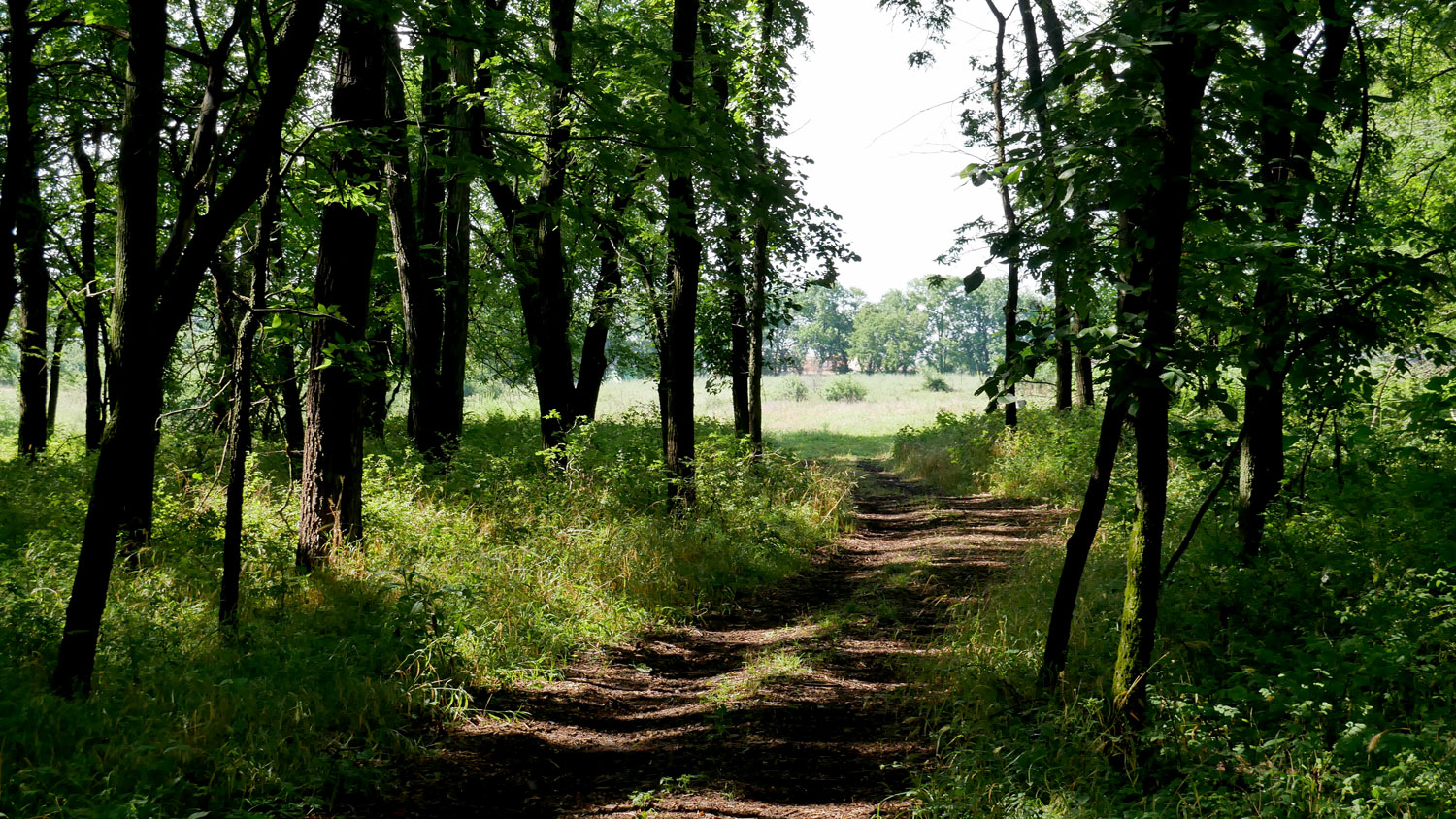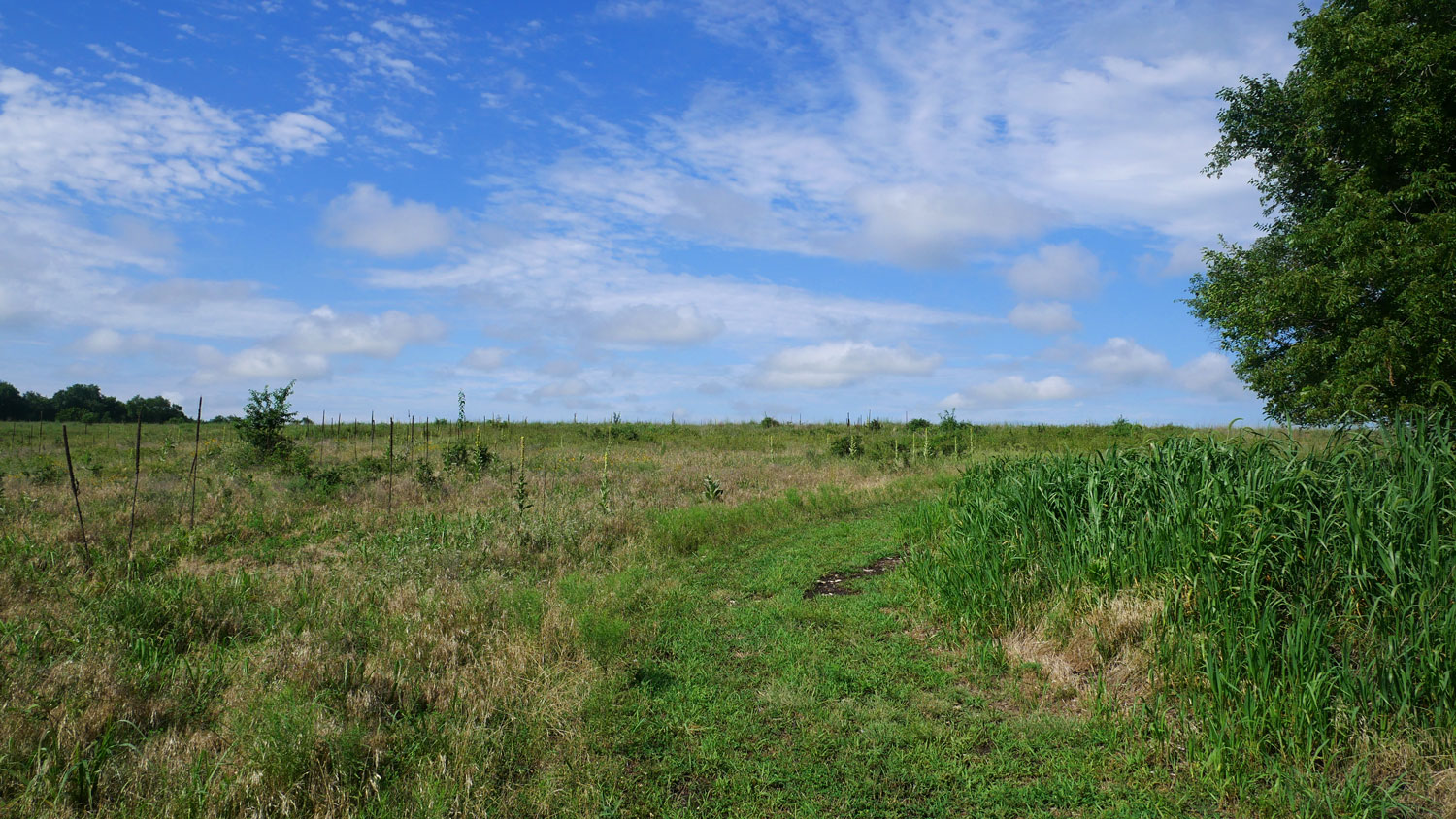Karen's Path
Karen’s path is a 0.3-mile natural hiking loop, featuring views of Wolf Creek, a native grass meadow, lower woodlands and a stunning Sycamore grove.
Nearly six miles of paved and wood chip hiking trails wind their way through the Overland Park Arboretum & Botanical Gardens.
The easiest of strolls are on the paths and sidewalks throughout the gardens. There are benches along the paths and walkways that meet Americans with Disabilities Act standards for accessibility.
The trails cross Wolf Creek, a major tributary of the Blue River, with two 75-foot bridges.
The Arboretum also offers visitors a chance to view and experience a variety of ecosystems and local plant species in 180 acres of open prairie area.
8909 W. 179th Street
Overland Park, KS 66013
913-685-3604
Daily | 9 a.m.-5 p.m.
Last entry 30 minutes before closing.
2024-2025 Holiday Hours:
Nov. 28 | Closed
Dec. 24 | 9 a.m.-2 p.m.
Dec. 25 | Closed
Jan. 1 | 9 a.m.-2 p.m.
Children ages 5 and under are free.
$2 ages 6-17
$5 ages 18+
Free admission on the first Tuesday of each month.



Each trail showcases a wide variety of tree species, native woodland plants and unique vegetation.
Karen’s path is a 0.3-mile natural hiking loop, featuring views of Wolf Creek, a native grass meadow, lower woodlands and a stunning Sycamore grove.
The cottonwood trail is a 0.4-mile mulched trail consisting of a gradual slope. This trail is named for the towering cottonwood trees near the east bridge. The cottonwood trail also features a bird watch area.
The sculpture garden trail is an easy half-mile asphalt walk through the Arboretum’s sculpture garden.
The west trail is a one-mile natural hiking trail that runs along the north bank of Wolf Creek before traversing the lower woodlands and a native grass meadow.
The bluff loop trail is a one-mile natural hiking loop with stunning limestone bluffs and mossy rock landscapes. The upper section of the trail features natural rock crossings while the lower section provides panoramic views of Wolf Creek.
The rocky ridge trail offers a one-mile, end-to-end, trek through the upper woodlands, passing limestone bluffs with rock fissures along a natural gorge. Cross footbridges over meandering streams. Two of the trail’s southernmost points stretch into the prairie, and visitors are welcome to explore the prairie on their own.
The whitetail pass is a 1.5-mile natural hiking trail consisting of many gradual slopes and natural rock crossings over streamways. This intermediate trail offers unparalleled views of Wolf Creek and western limestone bluffs.
The dry oak-hickory forest is a common ecosystem for this area, as well as for much of eastern and central North America. This ecosystem contains Post Oak, Black Oak and Shagbark Hickory trees as dominant species as well as rock outcroppings and rock layers at the surface. Dry Oak Hickory trees are examples of deciduous trees, meaning they lose their leaves every fall and winter and grow all new leaves in the spring.
Interesting Facts:
Riparian woodland ecosystems are areas along bodies of water that exist in the areas between water and land ecosystems. Woodland streambanks remove excess nutrients and sediment from surface runoff, helping to keep Kansas waters clean. The Arboretum’s Riparian Woodland ecosystem lies in the floodplain created by Wolf Creek. Floodplains are low areas next to streams and rivers that are created as the moving water erodes the stream banks over time. Flooding is visible and the soil is completely soaked at various times of the year. The Arboretum has experienced flooding events along Wolf Creek, usually about twice a decade.
Interesting Facts:
A dry-mesic prairie is a special grassy area with native Kansas grasses located on flat or slightly sloping land. Much of the Arboretum was originally prairie. Primarily located in temperate climates, prairies are big fields consisting of mostly grass instead of trees. The northeast entrance of the Arboretum and around Margaret’s Pond were once prairie, prior to the land being farmed. People plowed the land, grazed animals, and planted crops, so some plants that aren’t native to the area are currently growing there.
Since 2002, volunteers and Arboretum staff have been returning these old plowed field acres to their original natural prairie condition. The prairie is managed by a three-year rotation of reseeding, cutting, and burning to simulate grazing by wildlife and buffalo and mimic wildfires regularly burning the prairie.
Interesting Facts:
A Woodland ecosystem is a wooded area where the treetops hide 30 to 100 percent of the sky overhead. Breaks in the canopy allow sunlight to penetrate between the trees, reducing ground shade. A greater amount of available light reaching the ground means the ground is dense with trees and shrubs, climbers, perennial herbs, bulbs, grasses, sedges, mosses, and lichens. Canopy trees have large, spreading crowns, especially in more open, dry areas. No other local ecosystem contains such a wide range of plants as a Woodland ecosystem.
Interesting Facts:
A Mesic ecosystem retains moisture most of the year. This forest is dominated by a mixture of oak and hickory trees, with white oak being the most common. Red oak, black oak and mockernut hickory trees are also found in this ecosystem.
Interesting Facts:
A Wooded Draw ecosystem is a wooded ecosystem that has a natural drainage feature, carrying water from higher to lower areas. It contains steep-sided channels or gullies formed by soil washing away. Draws are often associated with forest, grassland, and desert ecosystems.
Interesting Facts:

Visitors can take the bluff loop and rocky ridge trails onto the prairie, where they may explore the beautiful landscaping on or off of the paths.
In addition to the rolling fields of big and little bluestem, switchgrass, prickly pear cactus and various native wildflowers, areas of interest on the Arboretum prairie include the old duck pond, two waterfalls, a cedar grove and a bluff overlook of Wolf Creek.
Arboretum staff and volunteers manage the prairie with a three-year rotation of reseeding, haying and burning to simulate grazing by wildlife and wildfire burning of the prairie.